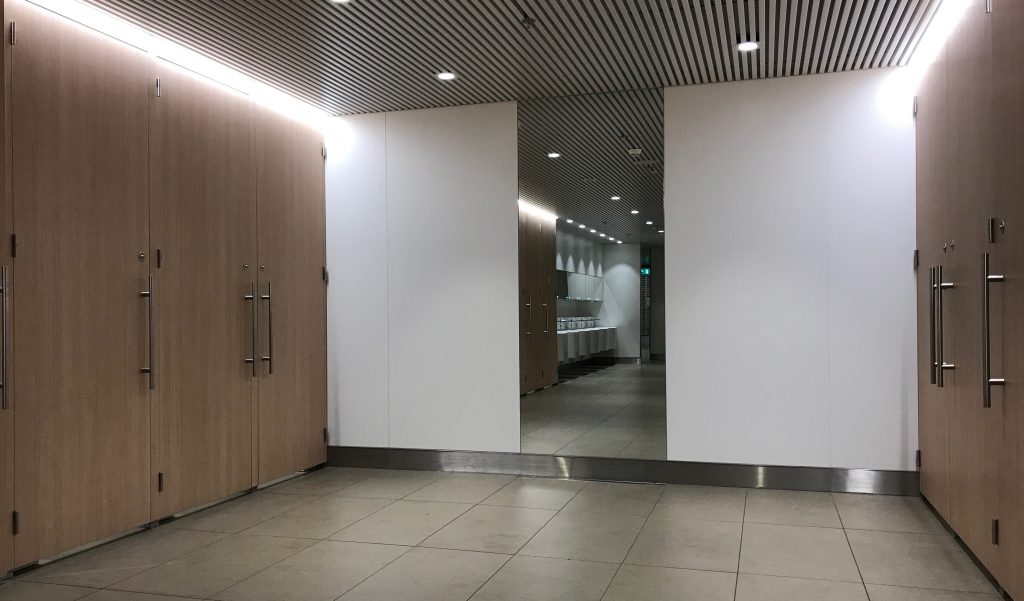Design Trends: Inclusion, Privacy, Efficiency, & Convenience

This attractive restroom in the new W Hotel in Bellevue, Washington serves men and women in the same space.
PRIVACY When men and women, kids, wheelchair users, and everyone else uses the same restroom, privacy is a key requirement. Out are stalls with panels that start nearly at knee level, rise a bit above your head and have peek-a-boo gaps. Inclusion calls for privacy – no urinals insight and individual rooms with doors that have no more than a 2-inch gap at the bottom. Cities such as Portland and Seattle, with their respective All User and Gender Neutral policies in place, are leading the way.
EFFICIENCY Inclusive restrooms have built-in potty parity. As soon as a stall is vacated the next user is served. Lines that form outside the ladies room unfairly cause women to miss part of a sporting event or the initial scene of a film or play. When there’s no similar line at the men’s room, the one at the women’s underlines the startling inefficiency of the traditional layout.
CONVENIENCE All of the above make it easier for users to meet their essential physiological needs. And we’re pleased to see additional features in our “public conveniences”. Hands-free options include doorless and S-shaped entries, stalls large enough to accommodate a travelers’ baggage, and sensors that flush, dispense soap, run warm water in the sink, and deliver towels or warm dry air. Enhanced with clean sightlines, quality wood and tile work, interesting artwork, live plants, and flowers, contemporary restrooms can put people at ease. In time, the free provision of menstrual pads and tampons in the washrooms of schools and workplaces will be seen as an integral part of restroom service.

Push through these doors for a surprise. From the outside, you have no idea lead into the same space.

Push open the “M” or the “W” and this hand washing area is in front of you. Gender neutral stalls line the walls on either side. In alcoves to your right and left are grooming stations.

The W Hotel restroom is off a busy hallway that leads to the bar. Directly across from the doors is an inviting alcove. The location is excellent example of CPTED (Crime Prevention through Environmental Design) as it permits the public and hotel staff to keep an eye on the facility.

Passengers at The Netherlands’ Schipol Airport enter spacious restrooms through doorless entryways. Attractive glass terrariums allow glimpses inside. Note how dispensers of soap and towels are out of the way.

Rows of stalls on either side offer the privacy required by today’s users.

Stalls are private rooms decorated with contemporary Dutch landscapes. Lights and flush are activated by sensors in the black wall plaque.

At Stockholm’s Airport, a small restroom serves hundreds of passengers daily as they transfer between planes and trains. The four all user stalls are off an airport concourse above a railway station with trains for all parts of Sweden.

Toilets with handrails accommodate passengers who have physical disabilities or are temporarily indisposed.

Universal Design practitioners use handrails that move out of the way for those who need to transfer directly from wheelchairs.

Considered by many as essential to a restroom as toilet paper, free pads and tampons are now frequently found in schools, universities and workplaces. This restroom is off the lobby of the Seattle headquarters of the Bill and Melinda Gates Foundation, where Menstrual Hygiene Management is also a part of their international programs.

Toilets on the Gates campus use Seattle rain to flush and offer two flush volumes. As public attitudes become aligned with climate change priorities, operationally efficient shared toilets serve the larger community.